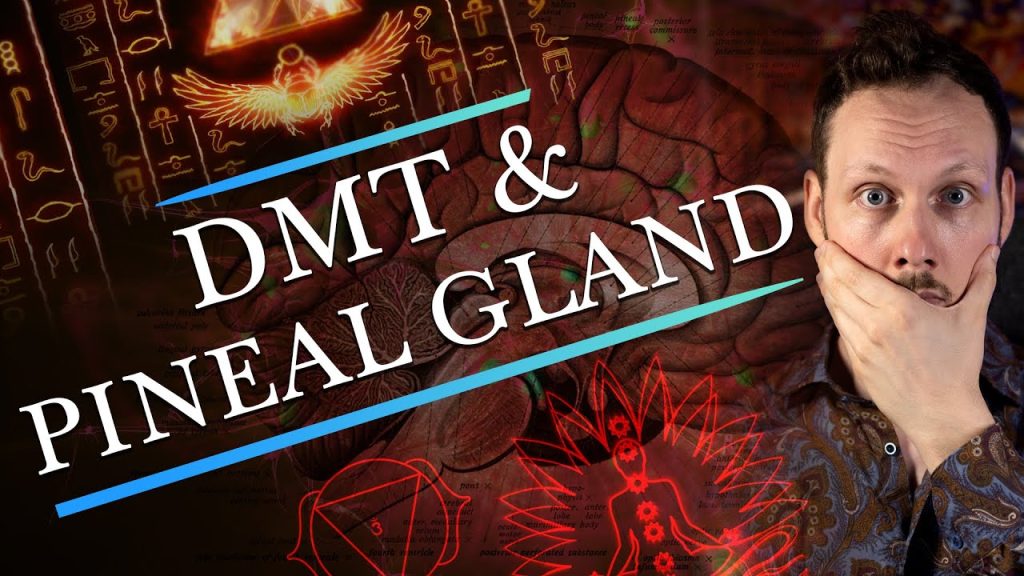DMT and the Pineal Gland: Is This the “Third Eye” of Spiritual Awakening?
Dimethyltryptamine, commonly known as DMT, is a powerful psychedelic compound that has long fascinated scientists, spiritual seekers, and mystics. Known for its intense, short-lived hallucinatory effects, DMT has been at the center of many debates regarding its role in human consciousness, the nature of reality, and its connection to spiritual experiences. One of the most intriguing aspects of DMT is its association with the pineal gland, often referred to as the “third eye” in spiritual traditions. This article explores the relationship between DMT and the pineal gland, investigating whether this connection could be the key to unlocking higher states of spiritual awakening and understanding. DMT and the Pineal Gland

What is DMT?
The Nature of DMT
DMT is a naturally occurring substance found in a variety of plants, animals, and even the human brain. It is chemically similar to serotonin, a neurotransmitter responsible for regulating mood, and melatonin, which helps control sleep patterns. DMT is typically consumed in the form of smoking or through traditional ayahuasca brews, which combine. DMT-containing plants with other plants that help facilitate its absorption in the body. When ingested or smoked, DMT can induce powerful visual and auditory hallucinations. Often described as otherworldly experiences involving geometric patterns, vivid colors, and encounters with alien-like entities.
The Hallucinogenic Effects of DMT
DMT is unique because of the nature of its hallucinogenic effects, which are often described as profound, surreal, and spiritual. Many users report experiencing a sensation of leaving their physical bodies and entering alternate dimensions, sometimes referred to as the “DMT realm.” These experiences are often accompanied by deep feelings of transcendence, unity, and profound philosophical insight. Some even describe their DMT journeys as encounters with divine or extraterrestrial beings. The brevity of the experience, often lasting only a few minutes, contrasts with the intensity of the sensations.
The Pineal Gland: The “Third Eye”
What is the Pineal Gland?
The pineal gland is a small, pea-shaped endocrine gland located deep in the brain. It is responsible for producing melatonin, a hormone that helps regulate sleep-wake cycles. In addition to its role in circadian rhythms, the pineal gland has long been associated with mystical and spiritual experiences. Ancient cultures, including Hinduism and Taoism, refer to the pineal gland as the “third eye” for spiritual awakening.
The third eye is thought to be a metaphysical gateway to higher states of consciousness, insight, and enlightenment. In this sense, the pineal gland is often believed to serve as a bridge between the physical world and the spiritual realms. Its role in regulating sleep and circadian rhythms has also led to the belief that it may be involved in dreams and altered states of consciousness.
Ancient Beliefs About the Third Eye
The idea of the third eye dates back thousands of years. In Hinduism, the third eye is associated with the Ajna chakra, a center of intuition and spiritual vision. The concept of the third eye also appears in other spiritual traditions. Such as Taoism and Buddhism, where it is seen as the seat of mystical perception and insight. The pineal gland has been connected to these ancient spiritual practices. With the belief that it holds the key to awakening one’s spiritual potential. DMT and the Pineal Gland
The Connection Between DMT and the Pineal Gland
DMT Production in the Pineal Gland
One of the most compelling theories regarding DMT’s role in human consciousness is its potential connection to the pineal gland. In the 1990s, Dr. Rick Strassman published DMT: The Spirit Molecule, exploring DMT production by the pineal gland.
Strassman’s theory suggests the pineal gland releases DMT during altered states, like dreaming, near-death experiences, and deep meditation.
This idea gained traction, particularly after Strassman’s research, which involved administering DMT to human subjects in a controlled setting. Moreover, some subjects in Strassman’s study reported experiencing intensely vivid, mystical, and otherworldly experiences, leading to speculation that DMT could play a key role in mediating spiritual or transcendental experiences. Although definitive scientific proof remains elusive, the connection between DMT and the pineal gland continues to be an area of great interest for researchers.
Is the Pineal Gland the “Third Eye” of Spiritual Awakening?
The idea that DMT is produced in the pineal gland suggests it may facilitate spiritual awakening.
Spiritual traditions associating the third eye with higher consciousness may describe the pineal gland’s role in mystical experiences.
If DMT is produced by the pineal gland, it could explain profound, life-changing experiences reported by users.
Furthermore, proponents of this theory suggest that the pineal gland, through the release of DMT, might allow individuals to access deeper layers of their consciousness, leading to spiritual insights and altered states of awareness. In this sense, the pineal gland could be a literal and metaphorical gateway to higher spiritual realms, as it is believed to open up the mind to experiences beyond ordinary perception.
DMT, the Pineal Gland, and Mystical Experiences
Near-Death Experiences and DMT
One of the most fascinating aspects of DMT’s connection to the pineal gland is the possible role it plays in near-death experiences (NDEs). Many individuals who have undergone NDEs report experiencing vivid, transcendent journeys, often involving encounters with deceased loved ones, divine beings, or a profound sense of unity with the universe. Some researchers, including Dr. Strassman, have hypothesized that the release of DMT from the pineal gland during extreme physiological stress, such as during a near-death experience, could explain these phenomena.
While there is no definitive scientific evidence to support this theory, the similarity between the descriptions of NDEs and the effects of DMT has prompted further investigation into the potential link between the two. DMT, as a potent hallucinogen, may alter the brain’s perception of reality, facilitating mystical experiences.
It could allow individuals to access alternate dimensions of consciousness.
Meditation and DMT
In addition to near-death experiences, many spiritual practitioners report that deep meditation can also lead to profound mystical experiences. Ego dissolution and altered awareness in meditation may be linked to DMT release in the pineal gland.
Proponents suggest meditation triggers DMT release in the pineal gland, facilitating spiritual awakening and a deep universal connection.
The practice of “third eye meditation,” which is common in various spiritual traditions, may also be linked to the idea of awakening the pineal gland. Through focused attention and mindfulness, practitioners aim to activate the third eye and access higher states of consciousness. If DMT plays a role in this process, it could explain why meditation and other spiritual practices often lead to profound personal transformations and spiritual realizations.
Scientific Challenges and Future Research
Lack of Direct Evidence
Despite the intriguing theories surrounding DMT and the pineal gland. There is currently no conclusive scientific evidence to directly link DMT production to the pineal gland in humans. While DMT has been detected in the pineal glands of certain animals, including rats and frogs. It remains unclear whether the human pineal gland produces DMT in significant amounts, particularly under conditions that would lead to mystical or spiritual experiences.
The challenge in proving this theory, however, lies in the difficulty of studying the human pineal gland in vivo. Additionally, as a small, deeply located structure in the brain, the pineal gland is difficult to access for direct measurement. Additionally, the production of DMT in the brain is thought to occur in microdoses, further complicating efforts to study its role in human consciousness.
Future Directions in Research
Future research must explore if DMT is produced in the pineal gland and its role in consciousness.
Advances in neuroimaging techniques, like functional MRI and PET, could help uncover DMT’s role in the brain.
As interest in psychedelics grows, new studies may reveal DMT’s role in mental health and spirituality.
With growing acceptance of psychedelic research, the mysteries of DMT and the third eye may soon be unraveled.
Conclusion: The Pineal Gland as the Gateway to Spiritual Awakening?
The connection between DMT and the pineal gland has captivated researchers, spiritual seekers, and mystics alike. The theory that the pineal gland acts as the “third eye” offers an intriguing perspective on consciousness.
Whether DMT is produced in the pineal gland or not, it significantly impacts perception and consciousness.
As research on DMT and the pineal gland progresses, we may better understand spiritual awakening and expanded consciousness.
